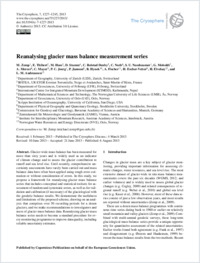Reanalysing glacier mass balance measurement series
- Zemp, M. Department of Geography, University of Zurich, Switzerland
- Thibert, E. Erosion Torrentielle, Neige et Avalanches, Saint-Martin-d'Hères, France
- Huss, Matthias Department of Geosciences, University of Fribourg, Switzerland
- Stumm, D. International Centre for Integrated Mountain Development, Kathmandu, Nepal
- Denby, C. Rolstad Department of Mathematical Sciences and Technology, The Norwegian University of Life Sciences, Ås, Norway
- Nuth, C. Department of Geosciences, University of Oslo, Norway
- Nussbaumer, Samuel U. Department of Geography, University of Zurich, Switzerland
- Moholdt, G. Scripps Institution of Oceanography, University of California, San Diego, USA
- Mercer, A. Department of Physical Geography and Quaternary Geology, Stockholm University, Sweden
- Mayer, C. Commission for Geodesy and Glaciology, Bavarian Academy of Sciences and Humanities, Munich, Germany
- Joerg, P. C. Department of Geography, University of Zurich, Switzerland
- Jansson, P. Department of Physical Geography and Quaternary Geology, Stockholm University, Sweden
- Hynek, B. Zentralanstalt für Meteorologie und Geodynamik, Vienna, Austria
- Fischer, A. Institute for Interdisciplinary Mountain Research, Austrian Academy of Sciences, Innsbruck, Austria
- Escher-Vetter, H. Commission for Geodesy and Glaciology, Bavarian Academy of Sciences and Humanities, Munich, Germany
- Elvehøy, H. Norwegian Water Resources and Energy Directorate, Oslo, Norway
- Andreassen, L. M. Norwegian Water Resources and Energy Directorate, Oslo, Norway
-
06.08.2013
Published in:
- The Cryosphere. - 2013, vol. 7, no. 4, p. 1227-1245
English
Glacier-wide mass balance has been measured for more than sixty years and is widely used as an indicator of climate change and to assess the glacier contribution to runoff and sea level rise. Until recently, comprehensive uncertainty assessments have rarely been carried out and mass balance data have often been applied using rough error estimation or without consideration of errors. In this study, we propose a framework for reanalysing glacier mass balance series that includes conceptual and statistical toolsets for assessment of random and systematic errors, as well as for validation and calibration (if necessary) of the glaciological with the geodetic balance results. We demonstrate the usefulness and limitations of the proposed scheme, drawing on an analysis that comprises over 50 recording periods for a dozen glaciers, and we make recommendations to investigators and users of glacier mass balance data. Reanalysing glacier mass balance series needs to become a standard procedure for every monitoring programme to improve data quality, including reliable uncertainty estimates.
- Faculty
- Faculté des sciences et de médecine
- Department
- Département de Géosciences
- Language
-
- English
- Classification
- Hydrology
- License
-
License undefined
- Identifiers
-
- RERO DOC 117992
- DOI 10.5194/tc-7-1227-2013
- Persistent URL
- https://folia.unifr.ch/unifr/documents/302950
Other files
Statistics
Document views: 146
File downloads:
- pdf: 188
- Supplementary material: 139
- Supplementary material: table: 77


